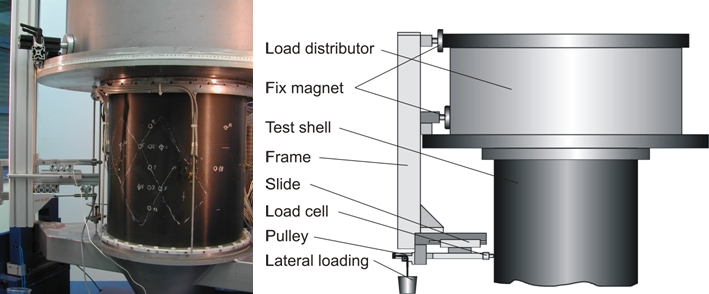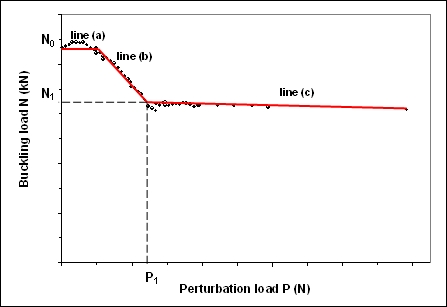
engineering & technology publications
ISSN 1759-3158
INNOVATION IN ENGINEERING COMPUTATIONAL TECHNOLOGY
Robust Design of Composite Shells: Simulation and Validation
*Institute of Structural Analysis, University of Hannover, Germany
+Institute of Composite Structures and Adaptive Systems, German Aerospace Centre (DLR), Germany
Previous investigations have shown that a single buckle is a realistic, worst case and
stimulating geometric imperfection of thin-walled cylindrical shells [1,2,3]. The single
pre-buckle is induced by a perturbation rig 1. The influence of a radial
perturbation load on the structural behaviour is investigated by applying loads of
different magnitudes and at different positions along the circumference. The results
of one perturbation position are shown in Figure 2. Each dot marks one test and
shows the buckling load ![]() as function of the perturbation load
as function of the perturbation load ![]() . The run of the
curve is shown by three lines (Figure 2). For perturbation loads larger than
. The run of the
curve is shown by three lines (Figure 2). For perturbation loads larger than ![]() the
reduction of the buckling load is quite small. This means that the perturbation load
the
reduction of the buckling load is quite small. This means that the perturbation load ![]() has to be increased very strongly in order to reduce the buckling load any further.
For perturbation loads
has to be increased very strongly in order to reduce the buckling load any further.
For perturbation loads ![]() single buckles are clearly visible, can be detected by
inspection and are therefore assumed to be unrealistic. The buckling load
single buckles are clearly visible, can be detected by
inspection and are therefore assumed to be unrealistic. The buckling load ![]() at the
intersection point of lines (a) and (b) is defined to be the new lower limit for the
buckling load of realistic imperfect composite shells.
at the
intersection point of lines (a) and (b) is defined to be the new lower limit for the
buckling load of realistic imperfect composite shells.
Based on the test results the numerical analysis is validated. The results of the tests and the numerical analysis are compared to the values of the NASA-SP 8007. The new approach leads to a much less conservative, but also safe, design. The possibilities for practical use are shown using a design example.
- 1
- M. Deml, W. Wunderlich, "Direct evaluation of the `worst' imperfection shape in shell buckling", Computer Methods in Applied Mechanics and Engineering, 149(1-4), 201-222, 1997. doi:10.1016/S0045-7825(97)00055-8
- 2
- T. Winterstetter, H. Schmidt, "Stability of circular cylindrical steel shells under combined loading", Thin-Walled Structures, 40, 893-909, 2002. doi:10.1016/S0263-8231(02)00006-X
- 3
- C. Hühne, R. Rolfes, H. Klein and J. Tessmer, "New Approach for Robust Design of Composite Cylindrical Shells under Axial Compression", European Conference on Spacecraft Structures, Materials and Mechanical Testing, ESA/ESTEC, Nordwijk, The Netherlands, 2005.
purchase the full-text of this chapter (price £20)
go to the previous chapter
go to the next chapter
return to the table of contents
return to the book description
purchase this book (price £90 +P&P)

